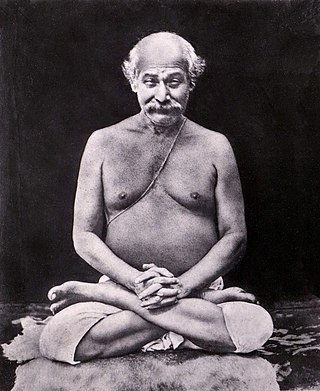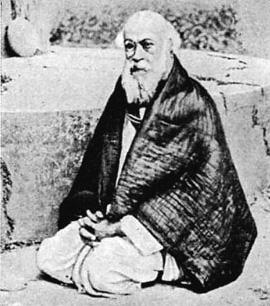Swami Yogananda Giri is a Hindu religious figure in Italy. [1] He was the founder of the Unione Induista Italia.
Swami Yogananda Giri is a Hindu religious figure in Italy. [1] He was the founder of the Unione Induista Italia.
Yogananda was born in Italy and converted to Hinduism when he was a teenager[ citation needed ]. After immigrating to India, he learned Sanskrit and became learned in South Indian Agamas. He was initiated as a renunciate monk in 1982. In 1985, he established the Gitananda Ashram in Savona.

Paramahansa Yogananda was an Indian-American Hindu monk, yogi and guru who introduced millions to meditation and Kriya Yoga through his organization, Self-Realization Fellowship (SRF) / Yogoda Satsanga Society (YSS) of India – the only one he created to disseminate his teachings. A chief disciple of the yoga guru Swami Sri Yukteswar Giri, he was sent by his lineage to spread the teachings of yoga to the West. He immigrated to the US at the age of 27 to prove the unity between Eastern and Western religions and to preach a balance between Western material growth and Indian spirituality. His long-standing influence in the American yoga movement, and especially the yoga culture of Los Angeles, led him to be considered by yoga experts as the "Father of Yoga in the West". He lived his last 32 years in the US.

Swami Sri Yukteswar Giri is the monastic name of Priya Nath Karar, an Indian monk and yogi, and the guru of Paramahansa Yogananda and Swami Satyananda Giri. Born in Serampore, West Bengal, Sri Yukteswar was a Kriya yogi, a Jyotishi, a scholar of the Bhagavad Gita and the Upanishads, an educator, author, and astronomer. He was a disciple of Lahiri Mahasaya of Varanasi and a member of the Giri branch of the Swami order. As a guru, he had two ashrams, one in Serampore and another in Puri, Odisha, between which he alternated his residence throughout the year as he trained disciples.

Shyama Charan Lahiri, best known as Lahiri Mahasaya, was an Indian yogi and guru who founded the Kriya Yoga school. He was a disciple of Mahavatar Babaji. According to the book America's Alternative Religions by Timothy Miller, Lahiri Mahasaya's life was described in Paramahansa Yogananda's Autobiography of a Yogi as a demonstration of the spiritual attainment that could be achieved by a householder "living fully in the world". A part of Lahiri Mahasaya's face is pictured on the cover of The Beatles' 1967 album Sgt. Pepper's Lonely Hearts Club Band.

Self-Realization Fellowship (SRF) is a worldwide religious organization founded in 1920 by Paramahansa Yogananda, the Indian guru who authored Autobiography of a Yogi. Before coming to the United States, Yogananda began his spiritual work in India in 1917 and named it Yogoda Satsanga Society of India (YSS). He came to the West in 1920 and in 1925 established SRF's headquarters at Mount Washington, Los Angeles, California. Before his return visit to India in 1935, he legally incorporated SRF in the United States, designating it as the only organization to carry on his work – to care for and disseminate his teachings.

Mahavatar Babaji is the Himalayan yogi and guru who taught Kriya Yoga to Lahiri Mahasaya (1828–1895). Babaji first became recognized through the writings of Paramahansa Yogananda, who devoted a chapter of his Autobiography of a Yogi to Babaji and founded Self-Realization Fellowship, a modern yoga movement that Babaji is associated with. The cave where Babaji met Lahiri Mahasaya, located near Ranikhet, is now a tourist attraction and place of pilgrimage in India.

Kriya Yoga is a yoga system which consists of a number of levels of pranayama, mantra, and mudra, intended to rapidly accelerate spiritual development and engender a profound state of tranquility and God-communion. It is described by its practitioners as an ancient yoga system revived in modern times by Lahiri Mahasaya, who claimed to be initiated by a guru, Mahavatar Babaji, circa 1861 in the Himalayas. Kriya Yoga was brought to international awareness by Paramahansa Yogananda's book Autobiography of a Yogi and through Yogananda's introductions of the practice to the West from 1920.

Kriyananda was an American Hindu religious leader, yoga guru, meditation teacher, musician, and author. He was a direct disciple of Paramahansa Yogananda and founder of the spiritual movement named "Ananda". He wrote numerous songs and dozens of books. According to the LA Times, the main themes of his work were compassion and humility, but he was a controversial figure. Kriyananda and Ananda were sued for copyright issues, sexual harassment, and later, for alleged fraud and labor-law violations.

Daya Mata, born Rachel Faye Wright, was the third president and religious leader of Self-Realization Fellowship/Yogoda Satsanga Society of India (SRF/YSS). SRF/YSS is the only spiritual organization founded by her guru, Paramahansa Yogananda, to disseminate his teachings. She was president of SRF/YSS for over 55 years until her death in 2010.

Mahendranath Gupta, , was a disciple of Ramakrishna and a great mystic himself. He was the author of Sri Sri Ramakrishna Kathamrita, a Bengali classic; in English, it is known as The Gospel of Sri Ramakrishna. He was also an early teacher to Paramahansa Yogananda, a famous 20th-century yogi, guru and philosopher. In his autobiography, Yogananda noted that Gupta ran a small boys' high school in Kolkata, and he recounted their visits, as they often traveled to the Dakshineshwar Kali Temple together. Having a devotional nature, Gupta worshipped the Divine Mother in the form of Kali, and often reflected the wisdom of his guru Ramakrishna in his daily life and mannerisms. Yogananda reverentially regarded Gupta's spirituality, calling him an "Incarnation of purity" and "the greatest man of humility I ever knew."Paul Brunton also narratives a meeting with Mahendra, in his famous memoir, 'A search in secret India'.

The Daśanāmi Sampradaya, also known as the Order of Swamis, is a Hindu monastic tradition of "single-staff renunciation" Ēkadandis were already known during what is sometimes referred to as "Golden Age of Hinduism". According to hagiographies composed in the 14th-17th century, the Daśanāmi Sampradaya was established by Vedic scholar and teacher Adi Shankaracharya, organizing a section of the Ekadandi monks under an umbrella grouping of ten names and the four cardinal mathas of the Advaita Vedanta tradition. However, the association of the Dasanāmis with the Shankara maṭhas remained nominal.

Swami Rama Tirtha, also known as Ram Soami, was an Indian teacher of the Hindu philosophy of Vedanta. He was among the first notable teachers of Hinduism to lecture in the United States, travelling there in 1902, preceded by Swami Vivekananda in 1893 and followed by Paramahansa Yogananda in 1920. During his American tours Swami Rama Tirtha spoke frequently on the concept of "practical Vedanta" and education of Indian youth. He proposed bringing young Indians to American universities and helped establish scholarships for Indian students.

Haidakhan Babaji, simply called Babaji by his students and devotees, was a religious teacher who appeared near the village of Haidakhan in northern India (Uttarakhand) and taught publicly from 1970 until his death in 1984. He has a following in the Western world, and two ashrams in India.
The Italian Hindu Union is an association representing Hinduism in Italy.

World Brotherhood Colonies are communities based on an idea envisioned by Paramahansa Yogananda, the Indian-American yogi who authored Autobiography of a Yogi and founded Self-Realization Fellowship (SRF) / Yogoda Satsanga Society of India (YSS). During the Great Depression in the United States, he encouraged readers of his East-West magazine to pool money to buy land where they could practice meditation and simple living in self-sufficient communities.

Hinduism in England is the third largest religion in the country, with over 1,020,533 followers as of the 2021 census. This represents over 1.8% of the English population, up from 1.5% in 2011 and 1.1% in 2001. Hindus are predominantly in the cities of London and Leicester, where they make up greater proportions of the population. England has a number of Hindu temples, including the Hindu temple at Neasden which is a large Hindu temple in Europe. In 2007, the largest Hindu Mandir in the North of England, the Bradford Lakshmi Narayan Hindu Temple opened in Bradford, West Yorkshire.
The reception of Hinduism in the Western world began in the 19th century, at first at an academic level of religious studies and antiquarian interest in Sanskrit.
There is a small Italian community in India consisting mainly of Indian citizens of Italian heritage as well with expatriates and migrants from Italy who reside in India.
Hinduism in Los Angeles made its first significant impact in the late 19th century when wandering Hindu monk Swami Vivekananda, a disciple of Ramakrishna Paramahamsa, came on his second visit to the United States. Swami Paramananda, a disciple of Swami Vivekananda, founded the Vedanta centres in Los Angeles and Boston.
Swami in Hinduism is an honorific title given to an ascetic who has chosen the path of renunciation (sanyāsa), or has been initiated into a religious monastic order of Vaishnavas. It is used either before or after the subject's name. An alternative form, swamini, is sometimes used by female renunciates.